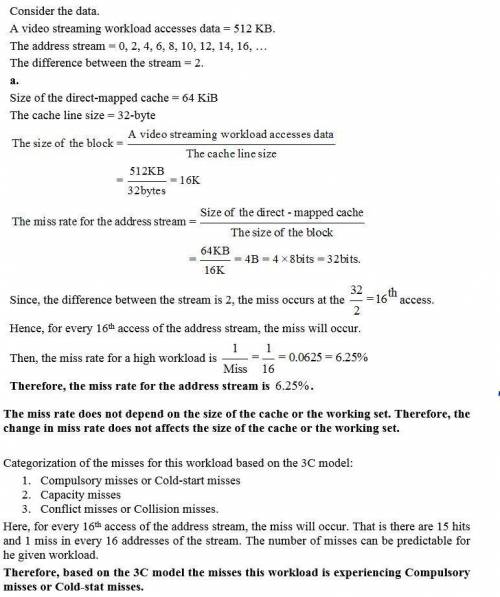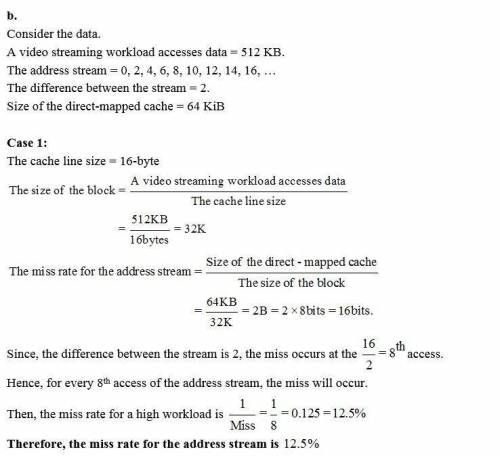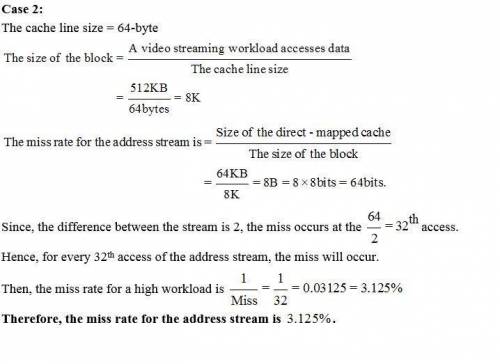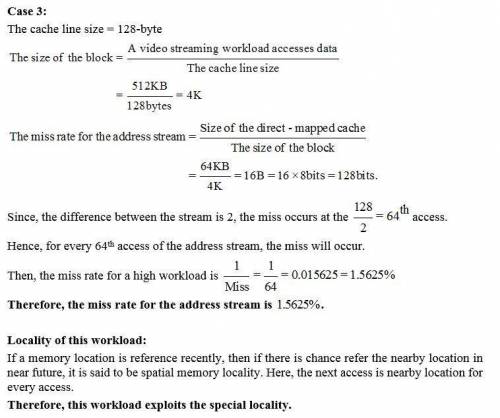
Computers and Technology, 08.11.2019 06:31, janeou17xn
Media applications that play audio or video files are part of a class of workkloads called "streaming" workloads (i. e., they bring in large amounts of data but do not reuse much of it). consider a video streaming workload that accesses a 512 kib working set sequentially with the following word address stream:
0, 1, 2, 3, 4, 5, 6, 7, 8, 9
a) assume a 64 kib direct-mapped cache with a 32-byte block. what is the miss rate for the address stream above? how is this miss rate sensitive to the size of the cache or the working set? how would you categorize the misses this workload is experiencing, based on the 3c model?
b) re-compute the miss rate when the cache block size is 16 bytes, 64 bytes, and 128 bytes. what kind of locality is this workoad exploiting?
c) "prefetching" is a technique that leverages predictable address patterns to speculatively bring in additoinal cache blocks when a particular cache block is accessed. one example of prefetching is a stream buffer that prefetches sequentially adjacent cache blocks into a separate buffer when a particular cache block is brought in. if the data are found in the prefetch buffer, it is considered as a hit, moved into the cache, and the cache block is prefetched. assume a two-entry stream buffer; and, assume that the cache latency is such that a cache block can be loaded before the computation of the previous cache block is completed. what is the miss rate for the address stream above?

Answers: 1
Other questions on the subject: Computers and Technology

Computers and Technology, 23.06.2019 23:40, dudedude1593
Which of the following calculates the total from the adjacent cell through the first nonnumeric cell by default, using the sum function in its formula? -average -autosum -counta -max
Answers: 1

Computers and Technology, 24.06.2019 00:30, petergriffin6772
Which boolean operator enables you to exclude a search term? a} not b} and c} or d} plus
Answers: 1

Computers and Technology, 24.06.2019 16:50, bella7524
7.23 main lab 7 - online shopping cart background this main lab extends the earlier prep lab "online shopping cart part 1". (you should save this as a separate project from the earlier prep lab). you will create an on-line shopping cart like you might use for your on-line purchases. the goal is to become comfortable with setting up classes and using objects. requirements this lab can be done individually or as pair programming. expanded itemtopurchase class (15 points) extend the itemtopurchase class as follows. we will not do unit testing in this lab so we will not be giving you the names of the member functions. create good ones on your own. create a parameterized constructor to assign item name, item description, item price, and item quantity (default values of "none" for name and description, and 0 for price and quantity). additional public member functions set an item description get an item description print the cost of an item - outputs the item name followed by the quantity, price, and subtotal (see example) print the description of an item - outputs the item name and description (see example) additional private data members a string for the description of the item. example output of the function which prints the cost of an item: bottled water 10 @ $1.50 = $15.00 example output of the function which prints the item description:
Answers: 1

Computers and Technology, 25.06.2019 05:10, jennynmike03
What is the output of the following program? #include using namespace std; class bclass { public: void print() const; bclass(int a = 0, int b = 0); //postcondition: x = a; y = b; private: int x; int y; }; class dclass: public bclass { public: void print() const; dclass(int a = 0, int b = 0, int c = 0); //postcondition: x = a; y = b; z = c; private: int z; }; int main() { bclass bobject(2, 3); dclass dobject(3, 5, 8); bobject. print(); cout < < endl; dobject. print(); cout < < endl; return 0 ; } void bclass: : print() const { cout < < x < < " " < < y < < endl; } bclass: : bclass(int a, int b) { x = a; y = b; } void dclass: : print() const { bclass: print(); cout < < " " < < z < < endl; } dclass: : dclass(int a, int b, int c) : bclass(a, b) { z = c; }
Answers: 3
Do you know the correct answer?
Media applications that play audio or video files are part of a class of workkloads called "streamin...
Questions in other subjects:


Mathematics, 09.12.2020 19:20

Mathematics, 09.12.2020 19:20

Mathematics, 09.12.2020 19:20


Mathematics, 09.12.2020 19:20




Mathematics, 09.12.2020 19:20











